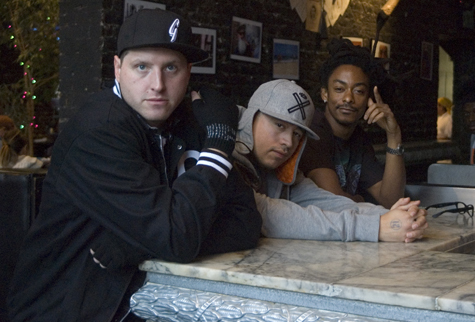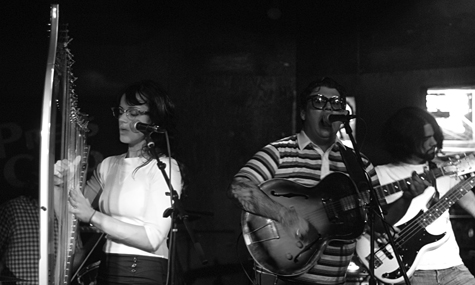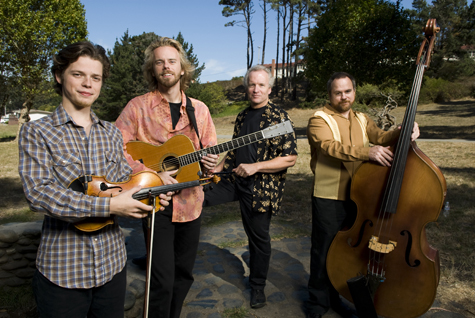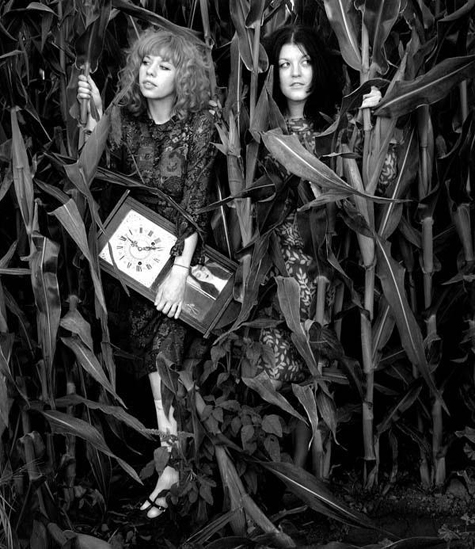One Block Radius rises out of The Dump and embraces a new music model
For seven years, One Block Radius’ sound has come forth from one location in North Hollywood, The Dump. It’s difficult to imagine recording in such a claustrophobic trash heap littered with Monster Energy cans, discarded potato chip bags and Del Taco wrappers, but the beginnings of OBR trace back to original members Marty James and MDA living in their trashy workspace.
It is one of the least glamorous tales with an attachment to Hollywood that you will read. James and MDA no longer live in The Dump, but it has remained the group’s recording temple. “Right now it’s at a new level of stank its never reached before,” James said. “I think the dumpier it is, the harder I work.”
The philosophy is common for producers: stop showering and grow a questionable moustache, anything to keep people out of your workspace so you can create in isolation. James knows that a gaggle of groupies won’t try to hang out amid the junk food dregs and lingering stale stench. “There’s no room,” he said. “Me and two other people can sit in there if I move some boxes around. At the same time, I keep connections with other studios should a more established artist come through. You can’t really be asking E-40 or Sean Kingston to come through The Dump.”
Recently Marty produced music for Motown recording artist MoZella for her The Straits EP. James said she brought her guitar to The Dump and even though she clowned on it, she survived the stay. “There’s no frills,” he said. “It’s where men come to make records. There’s no foo-foo bougie shit in there. It’s just get down.” It’s a workspace he intends to always keep, even if it’s merely for nostalgia.
With third member Z-Man living in San Francisco, the group clocks ridiculous travel hours that include James producing a foundation for a song at The Dump, then taking it to Street Symphony studio in Fremont, Calif. James said he values those trips to the Bay as opportunities to sink into artist mode. Living in Los Angeles, he’s consumed with being in collaborator/writer/producer mode. “I’m from up that way so I click into my artist mode,” he said. “It snaps me out of the songwriter hustle I’m always in.”
Originally from Chico, Calif., Marty earned his stripes with trips to Vallejo, Calif. Only a teenager, he worked in Rated Z studio, while they were recording ’90s hip-hop group N2Deep—maybe you remember “Back to the Hotel?”
“I got in with those guys by sending packages to any address I could find,” James said.
N2Deep producer Johnny Z took James under his wing, loaning out his MPC in the studio and allowing James to take his SP1200 back to Chico. James spoke of this era in his life with great significance as the engineers and music clerks he met in Chico lacked the knowledge of hip-hop production he gained in Vallejo. “I’d be playing them Ice Cube songs, and they’d give me all kinds of wrong information,” he said. So wrong they invented (only in their minds) an instrument called a “synchronizer” to explain the tricks of the trade. “I was going to music stores asking people for synchronizers,” he said.
James moved to Vallejo, forming his own group, Scapegoat Wax. The group released a few underground records until he moved to L.A. in 2001 and began his conquest of the industry. One Block Radius dropped its debut Long Story Short in 2005. The exposure from the debut, a mixtape and the “You Got Me” single led to a major label signing to Mercury/Island/Def Jam—a short lived experience.
With the terrain of the industry drastically shifting, major labels are essentially lost without a paddle as to how to properly promote a record. Still relying on radio play and other archaic promotional tools, OBR never had a chance at national success. James has no ill will toward the dissolution of the contract. “We were doing pretty good on the charts,” he said. “When momentum started to slow down we put our album out. It came and went fast. We probably should have held off, but there was a lot of good that came out of it.”
James said it was a learning experience, that given his prior history, he should have known better. For him, it was easy to get caught up in the whirlwind and excitement of being signed after years of independent grinding. Major labels aren’t suffering from an abundance of clients, but understaffing. It’s inconceivable that a rep can manage more than three acts in a day, let alone 15, which does happen! It only took a few months of major label life to recognize that the contacts James had established on his own would be all he needs to build a career. “The greatest part about the industry now is music can travel,” he said. “The first album still has a word of mouth attached to it.”
James recently inked a deal with DAS Communications, which handles The Black Eyed Peas, to manage OBR. He said he’s acted as his own manager throughout most of his career, but saw this as an opportunity to focus more on working in the lab, while his management handles his Twitter, Myspace and Facebook accounts. Because that’s the direction of the industry; being accessible digitally and not just having music, but being a personality in those vehicles. “It’s a challenging time to be an artist,” he said. “I think what’s happening is, no one is getting rich anymore and so the people that really want to be in music are the ones that stay in it.”
James is optimistic for OBR in this new world of music. He sees it as a singles driven market that rarely involves a well-conceived album. He’s not entirely turned off to a record deal as he is still in talks with people, but he said securing a record deal is low on the group’s priority list. “A group like us who is still just buzzing, we need to drop multiple singles,” he said. “We’re too self-sufficient to bother with a deal unless we are looking for radio play. I’ve yet to see a deal that does something for the group that we’ve not already created ourselves.”
This has been the core plan. James continues to build his name as a writer and producer, rubbing elbows with industry elite, while OBR works in the wings crafting catchy singles like “You Got Me” and its latest, “Broke Ass Holiday.” The single is a positive song about being grateful for what you have. For a group that began in a place called The Dump to still speak positively after seven years of being relegated to that spot, speaks to a humble presence in its members.
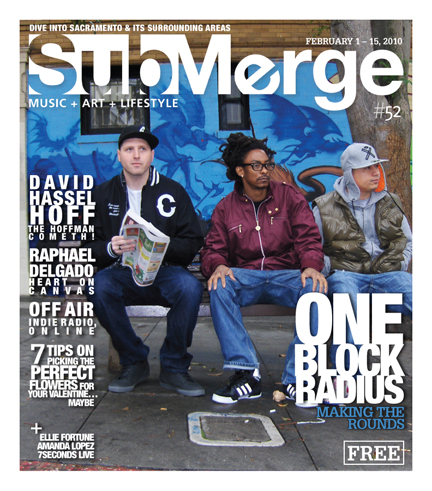
One Block Radius played The Blue Lamp on Feb. 10, 2010. First Place and The Freshmen also preformed.
All That They Can See
Don’t mistake San Francisco (by way of Davis) trio Sholi for a wholly identifiable musical collective. Their creative influences weave through minimalist shoegaze, Qawwali and the drone-y spiral of standing on a precipice, not knowing whether or not it’s time to leap. Their self-titled debut full-length, produced by Greg Saunier of Deerhoof, is an endurance test of the best kind; a sort of hopscotch through sidewalk chalk squares, hopping backwards with no knowledge of where the stone lies—guess wrong about a particular movement and you’ll trip and lose. Only according to vocalist/guitarist Payam Bavafa, Sholi isn’t interested in elaborating on the brainier elements of his band; but just hopes that listeners will create or find their own spaces with which to understand the band’s sound.
Established fans and newcomers will get their respective chances, as the band will celebrate the release of their debut on Feb. 14 at Delta of Venus in Davis. The album will be released nationally via Touch and Go/Quarterstick Records on Feb. 17, just two weeks before the band hits the music conference circuit with Noise Pop and SXSW. With so much going on, it’s a wonder Bavafa even had the time to carve out an interview with Submerge. He almost didn’t; but as with the stunning collection of angular neuro-rock his band has put out thus far, it’s definitely better to wait it out.
Sholi is a relatively new band, and you relocated during its formative months. How did the distance affect the band in the beginning?
Jon [Bafus, drums] and I started Sholi in Davis, and then I moved out to San Francisco for work. With the distance, things took a little longer to develop, but it was nice to be able to explore some ideas on our own before collaborating.
I’ve read that your relocation to San Francisco landed you a job as an electrical engineer for a sort of mad scientist. Can you explain what type of work you did, and how/if that work found its way into lyrical themes of your music?
I worked for a neuroscience research company. Most of the work we did had to do with capturing and analyzing EEG—brain waves. We studied sleep and memory among other things. I guess just working in this environment all day inspired some lyrical and musical ideas that explored the line between nostalgia and the “science” of how we actually process memories.
What kinds of theories of memory and the inner-workings of the mind interest you the most or are the most fascinating to you?
There’s a book by Pentti Kanerva called Sparse Distributed Memory that my research director gave me. It explores how memories are physically activated by means of association and attempts to construct a computational model of this idea. Pretty interesting stuff if you’re into technical reading.
Your 7-inch released on Holocene Music included a reinterpretation of Iranian ’70s pop musician Googoosh, as well as a cover of Joanna Newsom’s “The Sprout and the Bean.” Is displacement a central theme of your work as well? In what ways do you hope to invoke messages or insight to the plights of not only Iranians, but of all displaced peoples of the world?”¯
The Hejrat 7-inch was a separate project. I don’t know if our music attempts to do that necessarily, but it could be said that displacement is a theme explored in our music to some degree. Not so much in a “cultural” sense, as with Hejrat, but in notions pertaining to the development of one’s identity or a shift in one’s perspective.
Your new album will be released in just over a week, having been produced by Deerhoof’s Greg Saunier. What was it like working with him as a producer? What sorts of suggestions did he give you in terms of arrangements stemming from those initial production notes from your demos? Was it difficult to sometimes submit to ideas you didn’t come up with on your own?
Working with Greg was amazing. Production began while he was on tour in Europe. He sent us notes via e-mail about the demos he was listening to on his iPod. A lot of his feedback focused on concision, which is funny because we ended up with some pretty long songs. He helped us highlight certain elements of the music, balancing expressiveness of instruments and vocals, which is something that I think Deerhoof does very well. We wanted a producer who would be able to mold Jon’s intricate, complex drumming style with these melodic songs without making them sound too dense or overwhelming. Greg was very helpful in that regard. There were occasional creative differences, but in general, he would leave us with a bunch of suggestions, let us work on the songs ourselves for a while, and then come back to help finalize things.
Your music contains a lot of different movements in energy, it seems; are these movements intended to thrust the songs’ lyrical arcs through to the listener in a more cerebral way, or is being a sort of progressive indie rock trio kind of something you’re just drawn to musically? How might the rest of the band respond to that question?
We definitely put our own thought into structures and themes, etc., but none of them are intended to engage the listener in a more cerebral way, necessarily. If anything, I think we’d be happiest if people could listen to the album in a variety of environments and find whatever way they can to enjoy it.
Cannons and Clouds, Sound & Shape
Press Club | Sacramento
Sunday, Nov. 2, 2008
This was one of those shows that I had looked forward to for weeks. I randomly stumbled across the Myspace page of Sound & Shape and immediately knew I had to be there. It turned out that they weren’t the only band worth seeing; I was in for a pleasant surprise.
Before San Francisco-based group Cannons and Clouds even took the stage I was impressed. Any band that has an electric harp onstage (the stringed kind, not a harmonica) and wears nerdy, thick-rimmed glasses is OK in my book. For the next 30 minutes or so frontman Zachary Blizzard confidently boasted his deep, rich vocal style over their blend of pop-infused indie-rock. The higher ranged vocals of electric harpist Brittany Brunken sounded fantastic as the two harmonized seamlessly. Drummer Steven Medd sang quite a bit as well, further thickening the sound. What really made this band stand out was the addition of the electric harp. It sounded beautiful, elegant and traditional. It no doubt put an interesting and unique twist on the band’s music. It’s simple, yet engaging—not too complex or over played, anyone could enjoy it. Think Iron & Wine meets Death Cab for Cutie with a little Band of Horses thrown in for good measure. Cannons and Clouds seemed to have a decent amount of friends in attendance, and I was surprised and delighted to see at least a couple of people singing along during their songs.
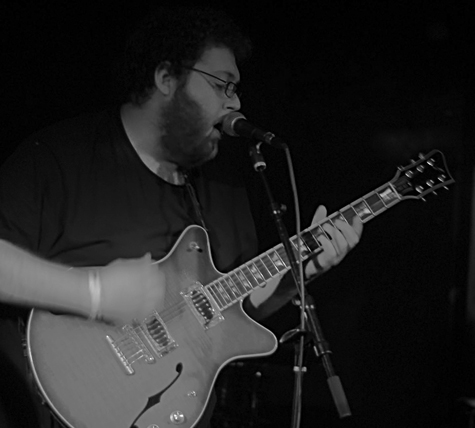
When the Nashville rock trio Sound & Shape took the stage and blasted into their set, the vibe immediately changed to a much more rockin’ one and the main focus became the incredibly fast and precise guitar playing of singer/guitarist Ryan Caudle. Drummer Jerry Pentecost must have had a few Red Bulls before the show because the amount of energy that he played with was quite intense. He was flipping and throwing his sticks all over the place while making extreme variations of the stereotypical “rock face.” David Somerall rounded out the sound very nicely with his locked in, ever so groovy bass playing. For just three guys, Sound & Shape have a huge sound that seems to lack nothing except more attention and recognition. If bands like Queens of the Stone Age and Wolfmother can, it’s safe to say that Sound & Shape might be the next to hit it big.
The show ended on a high note with Pentecost jumping onto his drum stool and back onto his kit perfectly in time with his band mates distorted final chords. It was a great wrap up to the evening and my associates and I had been sufficiently entertained.
Java Lounge, Sacramento
Sunday, June 29, 2008
Sunday evenings for me are usually reserved for the couch, a six-pack and a movie. It’s like clockwork. So naturally I found myself in a bind when I learned there were some killer bands set to play at Javalounge last Sunday. It was indeed a tough decision, but ultimately I determined it was good to get out of the house and go see a very small, intimate show. It was a wise choice.
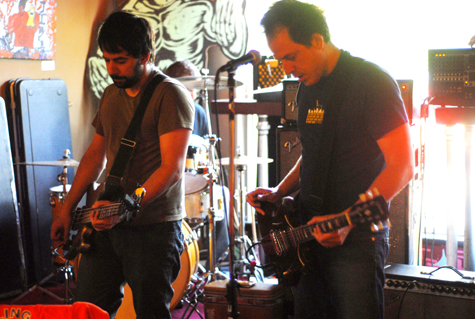
As I walked through the doors of the small coffee shop I immediately thought to myself, “I bet everyone is laying on their couch watching a movie,” because there was maybe nine people inside, including San Francisco’s indie-fuzz rock group Calling All Monsters. As the band began their set, I quickly realized that all those not in attendance were missing out big time. CAM’s songs were short, sweet and jam-packed with loud fuzzy guitars and shouted vocals. None of the songs seemed to last more than three minutes, which gave the set a very punk rock show feel. They earned brownie points for that right there. Overall, Calling All Monsters’ set was very fun to watch and ended much too quickly. I highly advise you check these guys out if you like loud, feedback riddled rock ‘n’ roll crafted in a tasteful, elegant manner.

The next group of bearded men set to play was West By Swan out of Chico. I’ll be honest; this was the band I really came to see. I have had the pleasure of witnessing them perform many times and never once have I been disappointed. I think it’s mainly because they sound like two of my favorite bands that are nothing alike (Fugazi and Explosions in the Sky) all mashed together. After a spacey instrumental intro full of ambient noises and guitar loops via vocalist/guitarist Dan Greenfield, the group launched full force into their heavier distorted songs. Toward the end of the set Dave Greenfield (guitar) pulled out an electric 12-string guitar, which added an awesome chorus effect. The rhythm section, consisting of Daniel Taylor (drums) and Conrad Nystrom (bass), played so fiercely that my cup of water had ripples in it. I found this to be quite humorous because I had been watching Jurassic Park right before the show and the T-Rex was causing water in puddles to ripple. So, I guess you could say that West By Swan rocks as hard as a T-Rex walks, which is real hard. Keep an eye out for these guys because I know they will be back soon, hopefully with their new record (rumor has it it’s almost done) in tow.
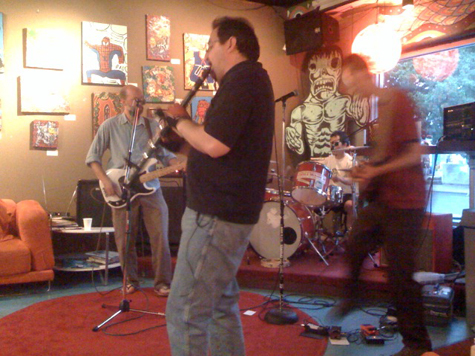
As the third and final band began to set up their equipment I realized they had a clarinet player and I was immediately intrigued and excited to hear what would become of this rare instrumentation. I soon learned they were dubbed San Kazakgascar, a local group made up of Jed Brewer (vocals, guitar), Greg Hain (bass, vocals), Paul Takushi (drums, vocals) and Mike Woo (clarinet, vocals). As their band’s name suggests, they have a very Middle Eastern vibe. About halfway through their set, Brewer introduced the song “National Anthem of San Kazakgascar” by saying, “People have trouble with our name so we wrote a song where we say it over and over again.” It was definitely effective because after that song I had no problems trying to properly pronounce their name. That’s damn good marketing right there, all bands should have a song where they just repeat their own name. OK, maybe not all bands. Anyways, San Kazakgascar plays a very interesting and unique (at least to this scene) style of music full of vocal chants and barks and all kinds of other fun noises. I suggest you step outside your comfort zone and give them a shot. I did, and I don’t regret it one bit.
Aesop Rock Wins
By Ron Barker
Aesop Rock has been a busy man this past year, releasing a full length album (None Shall Pass on Definitve Jux) and a 45-minute Nike+iPod track (All Day) as well as touring three different continents. As if that wasn’t enough, Aesop recently released a new track on his Myspace page in collaboration with Tobacco and booked a handful of shows on the west coast. I don’t know how he found the time to respond to all the questions in my e-mail. Aesop Rock, you’re a winner in my book.
Your new song “Dirt” is banging. What was working with Tobacco like? How did you guys hook up?
Thanks so much! Tobacco is one member of the group Black Moth Super Rainbow. “Tobacco” is the name he goes by for his solo work. I brought BMSR on tour with me for a lot of shows last year. I have always toured with close friends, but I decided to try to switch it up, listen to a lot of new music and blindly pick something I thought was good. I heard many, many, many terrible albums. The two that stood out as gems in an otherwise shitty pack were BMSR and the Octopus Project, who also joined us on tour for a few weeks last year. Anyway, me and Tobacco are mutual fans, and became friends over the course of the tour, we kinda all became friends, everyone on the shebang. So a couple weeks after that tour ended he sends me the beat, and I liked it a lot, and that was it. He’s got a really great sound. It’s lo-fi, but not in an annoying way, a lot of weird moods that you don’t hear often with hip-hop drums behind them.
You just got done with a lot of touring. How’d that go? Any interesting stories?
It was pretty fantastic. I mean, it also sucked at times. The fantastic times were fantastic, though. The actual shows were really great, tons of people, great vibes, good shows. Met a ton of people every night that have been supporting for many years and that is always the best shit ever. The shitty parts were shitty. Being on tour is not easy. I guess some people find comfort in it, but I don’t, and I really kinda have to pace myself. We did a long run in the US, and then to Europe, then Australia. It’s a lot of travel, a lot of time in your own head within unfamiliar surroundings. That type of stuff doesn’t cater well to my creative energy (pardon that expression), and at the end of the day I really am here to make songs. That’s what I like to do. Point blank: it’s stressful, a lot of pressure. But I loved traveling with Blockhead, and I always love Rob [Sonic] and [DJ Big] Wiz.
Last I heard, both you and Mr. Lif had moved to San Francisco. Did Murs talk you guys into it? Has Def Jux been affected by the move? Do you miss New York?
Def Jux is fine. Everyone is scattered geographically, but it’s not affecting the music. I mean as much as it can be perceived as a working unit, it should also be perceived as a bunch of individuals that got this way from hiding out and making tracks. At the end of the day, we all crawl back into our holes and loop some drums. Then we meet up, show each other the new shit, and repeat. Lif is no longer in the Bay. He’s like everywhere. Murs did not talk me into it, but I feel honored to share a piece of his coast for the time being. I’m just buggin’ out for a while. Heading back east at some point when I get around to it. Or maybe moving to a far away land, as in alternate reality or dimension.
Camp Lo makes a guest appearance on Bazooka Tooth, and if my ears don’t deceive me, you’ve sampled them on “Getaway Car.” Can I look forward to a third collaboration?
I would imagine yes at some point. Those guys are amazing—two of my favorite MCs. We just rocked a show together in Toronto earlier this year, and it was great. We’ve spoken about doing more shit, I think it just boils down to everyone being in the same place at the same time.
Tell me about working on All Day. How did the creative process for that type of project differ from other albums?
Well to boil down the problems that need solving in a project like that I guess the major hurdles were that they wanted one 45-minute track. They wanted no samples. I personally felt a quick-pace would work best, so I chose to work within the confines of a 100-120 BPM range, which is fine and all, but I’d never done that much at that tempo. Maybe one or two songs per album are near that. For hip-hop, that’s relatively quick. I just kinda made the outline of a 45-minute song. Then went in and spruced it up, made it change over every minute or so, so it was this kinda ever-morphing tune—some small vocal choruses and such. Played some bass. Recorded some guitar from my lady. I dunno it was very weird. But quite fun. It was a hectic time because my solo album was due a couple weeks after so I remember being frazzled, but it was cool nonetheless.
What have you been listening to lately? Any new rappers worth checking out? Old ones?
Lately I have been listening to a lot of Howard Stern. I like that new Outkast song with Raekwon. I like this beat that El-P just sent me. I like this new Cage song, “Dr. Strong.” I like this Chin Chin record a lot. I like this Clipse mixtape #3 not as much as #2, but it’s dope and is getting run. I can’t think of anything else I’ve heard.
Def Jux has done a bit of cross promotion with Adult Swim, and your last record got a decent amount of airtime on MTV. How has the extra exposure worked out?
The exposure has been great, but it only works when I can back up everything they make me look like. Some days I can, some days I can’t. I guess that’s where the hiding part comes in. I had a busy year, which kinda kept my name popping up a bunch. It was cool that more outlets took notice and helped me out.
How did the Build Your Own Bazooka Tooth idea work out? Any possibility of a similar instrumental/a cappella release for None Shall Pass? Any upcoming projects?
Yes, actually in mid-May we will release the instrumental, a cappella and lyrics to None Shall Pass through a revamped Def Jux site [www.definitivejux.net]. The lyrics are accompanied by the photos of Chrissy Piper. She supplied 16 images for the downloadable PDF. It will be free. The instrumentals and a cappellas will be normal price.
The Waybacks Get Loaded
San Francisco-based roots rock group The Waybacks took a step forward with their latest release. Due out in late March on Compass Records, Loaded, will be the band’s first release to feature all original material. The album was recorded on the hallowed musical grounds of Nashville, TN–the city in which frontman James Nash was raised, with producer Byron House. In anticipation of Loaded‘s release, Submerge spoke with Nash from his San Francisco home where he was preparing for a stint on the road that will take The Waybacks through western Canada.
You were raised in Nashville. How long have you been living in San Francisco?
I’ve been out here for a while. I moved out to the Bay Area in 1991.
Do you go back to Nashville often?
We go there to play some now. Our official record release date I think is the Nashville show in a couple of weeks. I used to spend more time going back there when my parents lived in Nashville, but they don’t live there anymore. I don’t visit as much, but Nashville is a great town—a great music town, obviously—and our record label is based there. We did our last album in Nashville.
I saw that the producer [Byron House] is from Nashville also.
Yeah, he’s not just from Nashville, he’s like one of the A-list studio players there. He knows everyone in town, and that’s one of the main reasons we recorded there, because it felt like it was good to have someone who knew the town, and all the players. Every now and then we thought, “It’d be cool to have accordion on this song,” and he was like, “Oh, well, I’ll have someone in here tomorrow morning.” He knew all the cats in town.
I would imagine that there must be a lot of amazing musicians down there that most people don’t know about.
Oh, it’s unbelievable. The old Loving Spoonfuls song is definitely true about—I forgot the number—but there are 1,852 guitar pickers in Nashville, and all of them pick it better than I will. It seems like everyone plays guitar in Nashville, but there are a whole lot of other styles and different instruments, of course.
Did you get to work with anyone you were taken back by?
One big thrill on this record was getting Sam Bush to come in and play on a track [“Loaded”]. We were psyched to have him on the record, but what was really cool was that we didn’t just get him to come in to overdub a solo on the song, we actually had him track the basic song with us, which made a big difference. It’s always cool to have a star come in and overdub a little lead part on your song, but to actually have someone of Sam’s caliber come in and play the song with us really changed the way we approached it. Not just his part. Everyone adapted what they were doing to fit what he was doing. He’s the kind of guy that if he’s in the room, or if he’s on the stage, everything sounds different. It was really cool to inject that kind of energy into what we were doing.
This is the first album you did without any covers, is that correct?
Yeah, I think that’s right.
Was that your intent when you went into the studio?
We had a real productive period with the writing over the last year. It just kind of worked out that way. This record was done more, as far as the material when we went into the studio on day one than any album we’ve done before. We had 15 songs that we wanted to record, so we needed help with Byron to see which ones would get the axe on this particular record.
We kicked around a couple of cover ideas, but an album can only be so long, and we sort of felt like, “Well, to do a cover, we’re going to have to boot off one of these original tunes, and which ones are we going to cut?” I’m really excited about that, honestly, because it’s a strong new direction the band is taking, where we really are basing our sound entirely on new, original material.
Covers can be cool if they’re done the right way, but they can kind of become a crutch of a band, I think. It feels really nice that, hey, we’re going out on stage every night, and we’re not relying on people—in some cases—knowing our songs. There’s a whole different feeling that you get getting out in front of an audience and playing songs where they don’t know most of them. That’s what it feels like right now, and it’s not easy to sell people on stuff that isn’t familiar, so I think in some ways it makes us play a little harder and sell the material, because it’s like, “These people don’t know the stuff, so we got to go out there and really give them something.”
You mentioned that you were going through a very productive period. Do you have any insight as to why that might be?
I think both Warren [Hood, guitar] and I had a lot to say last year, and that feels really good. I wish I had the answer to how to do that, because then I’d be productive all the time. It’s funny, sometimes you sit down—one way I like to illustrate it is that I’ve been playing guitar all my life, so if I sit down and strum a D chord, I know what it’s going to sound like before I hear it because I’ve heard it a thousand times. Most of the time, when I sit down and strum a D chord, it just sounds like a D chord, but on a good day, I sit down and strum a D chord and it sounds like the first note in a song. I can’t explain why that is, but just sometimes you sit down and play your instrument, or you sit down without playing an instrument, and you hear something that suddenly sounds new, whereas I feel like the sad thing about music is that most of the time it all sounds like something you’ve heard before and that’s why musicians are always listening to other bands because they’re looking for something new. Most of what I play sounds boring to me, but then every now and then it’s like, “Oh wow, that’s new. That’s great,” and then I stay up all night and write a song, and I’m a happy guy.
Artists Joseph “Bron4000” Molina and Ayami Suzuki-Molina Set their Sights on Second Saturday
Though there haven’t been many dry days so far this year, there are far worse ways to spend a Saturday night than strolling around the city and perusing the works of different artists. Second Saturday provides Sacramentans with the opportunity to do just that, with galleries through out the city staying open late to receive guests as well as host artists whose works are on display. The next Second Saturday will take place on February 9th, and two artists you’ll be able to familiarize yourselves with are Joseph “Bron4000″ Molina and his wife Ayami Suzuki-Molina, who will be showing their work alongside Bradley Platz and Josh Heilaman at SaraJane & Co. at 908 21st Street in Midtown. The San Francisco-based Molina (with a little help from Ayami) answered a few of Submerge‘s questions regarding the couple’s upcoming gallery show and his artistic background.
I saw that you and Ayami Suzuki had done a show together at KidRobot in San Francisco. The two of you are married, correct? How did you two meet?
Bron4000: Yes… to each other. I tugged at the red string tied to my pinky and her pinky happened to be tied to the other end of it. She’s a Molina now.
What are you bringing to the show in Sacramento? Is it different than last year’s show at KidRobot?
Bron4000: A little bit of this and that with some of those over there. I would like to think the new pieces are different from the KidRobot show. I would hate to be that “stuck artist”… too many of those. I might revisit an idea or two and flip it. After the pieces are hung… my opinion gets thrown through the window because it’s up to the viewer to formulate there own interpretations so, I’ll leave that up to y’all to decide.
The show at SaraJane & Co. in Sacramento also features the work of Bradley Platz and Josh Heilaman. Are you familiar with both these artists’ work?
Bron4000: I am now.
Ayami Suzuki-Molina: Me too.
Both at the same time: Interesting.
From what I’ve read, you were involved with the graffiti scene in San Francisco. Is this how you got your start as an artist?
Bron4000: I actually got into art from cartoons and Marvel comic books. John Romita, Sr. plus [John Romita] Jr. equals magma loogies. Graffiti had always been around, but it wasn’t until about ’82 when I caught my cousin doing it. Then I started to differentiate gang stuff from the dope shit. Thanks Swaz1er! Then I started biting folks like Dondi and Vaughn Bodé. I got foundations in San Francisco, but it was when I was living in Sacramento that I started to refine my stuff and began to get more notice.
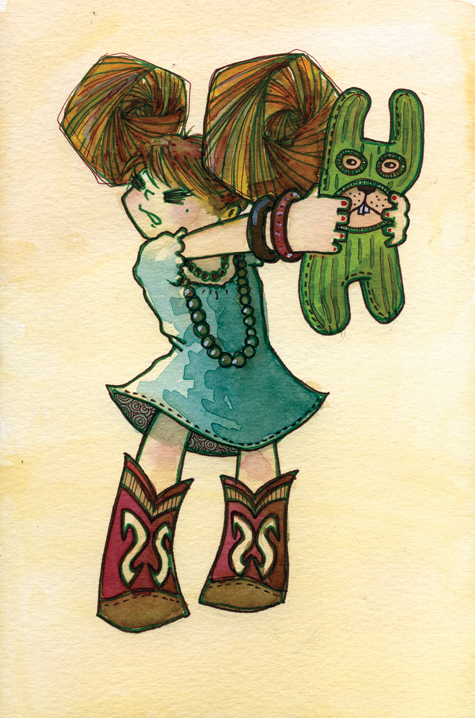
How has the graffiti scene in SF changed since you’ve been involved in it?
Bron4000: Same baloney, different bread. Including myself at times. One thing I can’t stand is the hipster graffiti heads… 85 percent of them.
Had you always had designs to move more into the fine art realm?
Bron4000: I guess so… What I do love is the creative process—the more outlets, the better. The transition from graffiti to gallery is tough, because once it’s on a canvas it’s no longer graffiti. I would love to make that fine art money, though.
Looking at the characters you paint, I see a lot of different things in them—from pop culture icons to perhaps a bit of an anime influence—and they have a sort of cartoon-y feel. Did you watch a lot of cartoons growing up? Do you still? If so, which ones do you think had the biggest impact on you as an artist?
Bron4000: Adult Swim. I wish it was on all day, but then I might as well get into Star Trek. Voltron, Tranzor Z, RoboTech, Transformers… whatever. I even watched The Snorks, Paw Paw Bears, Black Star, She-Ra, fuck it. Nowadays I like Aqua Teen Hunger Force, some SpongeBob and Ben 10. I don’t like the new Teenage Mutant Ninja Turtles. Saturday TV Fun House. Hell yeah … I think the writing in those cartoons is genius… even those old racist ass Warner Brothers ones. Droopy Dog was a pimp. South Park is kingin’ ’em all… Butters for Prime Minister! My wife being Japanese has nothing to do with any anime influence.
I saw that you’d done a vinyl figure for the KidRobot show. Is this something you hope to do more of?
Bron4000: Yes, I think I might have one for this upcoming show hopefully. I actually like painting those things because it’s 3-D. We’ll see…
When I was doing some research on you, I saw that your name also came up in regards to music. Do you also record? If so, how would you compare that creative experience as opposed to your artwork?
Bron4000: At times you can find me behind a mic, but not as much nowadays. I still keep writing rhymes, though. Gotta keep the sword sharp. Addict Merchants …yehbebeh. Music is more therapy for me. My focus has always been to paint. As far as the creative differences … with a band, it’s a give and take because there are more entities involved and you can only move about within certain perimeters without causing a conflict of ideas. It happens. You can only let so much out before the collective thinks you’re nuts.
In painting, it’s free jazz… all day. The influences are the same, though … at least for me. The thinking process is the same, just different ways of application. If you’re not looking for the perfect beat, then you’re looking for the perfect line or stoke. I haven’t found either.
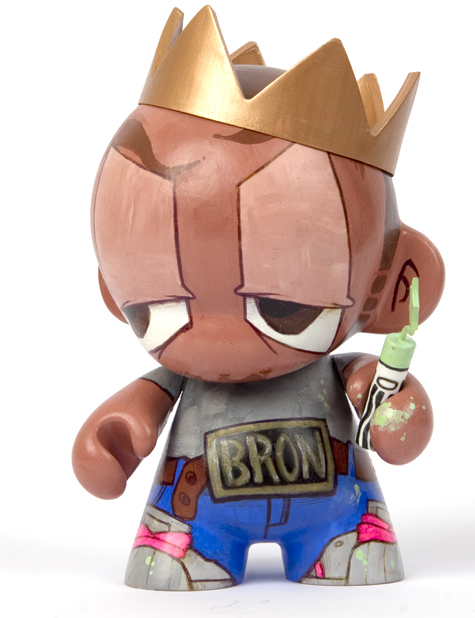
Some things were just meant to be. Listening to the music of Sacramento locals Agent Ribbons, you’d think the group had been together forever. There’s an almost preternatural chemistry between vocalist/guitarist Natalie Gordon’s warm, rich guitar tones, her equally resonant vocals and drummer Lauren Hess’s smoothly shuffling rhythms. However, Agent Ribbons have yet to enter their terrible twos (that’ll happen this coming March). In fact, before she met Hess, Gordon, who had been playing sporadic solo shows prior to her work with Agent Ribbons, seemed like she had run her course with performing music.
“After hitting a dead end in songwriting around then, I sold my guitars and didn’t play for a year,” Gordon explained over a brief e-mail correspondence. “Meeting Lauren was a turning point for me and brought invention and inspiration back into process of writing music, and from there we developed a symbiotic approach to the music we create.”
Was it fate? Maybe. But it’s probably best not to overanalyze. What makes Agent Ribbons’ music so engaging is its enchanting simplicity. Gordon took the time from her busy schedule as an employee in an “independent sweat shop” to answer a few of Submerge‘s questions via the mystical strands of the World Wide Web.
I’d read in an older interview that you (or had) lived in a Victorian home. Listening to your music, I got the sense that it had a nostalgic quality to it. Are you a history buff, and if so, what period of history holds the most interest for you?
I was an art history major during my brief stint with scholarly pursuits. I do prefer historical fiction and biographies over most genres…one of my favorite books is called The Fall of Madame X and almost entirely because of my fascination with that story I think I’d like to be in Paris in the 1880s. It’s such a romantic time and place to be in, but probably only for the rich.
Do you and Lauren still inhabit different apartments in the same building?
Lauren lives in the flat below in our building, though half the time she lives in San Francisco where she is employed in a bead shop.
In your first e-mail to me, you’d mentioned that you had a hectic schedule due to your new job. Does work stress affect how you write songs or what you choose to write about?
Actually, having structure and repetition really helps my creative process. Almost all our songs were written whilst riding in the back of a car, on long walks through downtown or ironing because I drift into that space when I’m bored or have the freedom to daydream. Right now, I’m working as the assistant to a corset maker, though I like to tell people that I work for an “independent sweat shop.” Anyway, corset making demands an attention to detail, so I write when I get home.
Reading the lyrics for a couple of your songs on your SonicBids page, it seems that your lyrics are character-driven. Would you say that’s a fair assessment? If so, where do you find inspiration for these characters?
Most of the songs tell stories instead of convey only ideas, I guess. And a good story relies on strong and memorable characters, so I spend a lot of time developing that aspect, almost unselfconciously. Most of the stories I come up with are a hybrid of personal experience and either movies or books. The space I am in when watching a film or reading—especially escapist-type stuff—is the place I’m in while songwriting. So I draw much of my inspiration from movie theaters, but create my own plot and characters, but much of the song is emotionally drawn from actual life.
I saw that your 7-inch, And the Star-Crossed Doppelganger, had a cover drawn by Dame Darcy. How did you meet up with her, and what was it like working with her?
She happened to be on tour with her own band, Death by Doll, and so we asked her to play at our CD release party when she came to the area. She actually stayed in my room for a couple days and I was a bit breathtaken for all of the first day. However, after realizing how fun and dorky she was, it evolved into more of a friendship and she let us stay with her when we came to Los Angeles. We were so honored to work with her on the 7-inch and she seemed very pleased to do it!
Had you been a fan of her work and comics prior? Are you a regular reader of comic books in general (I am, so I won’t make fun of you for saying yes)?
I would not consider myself a comic book fan in general, but I have been reading Dame Darcy for years and was a fan of her solo music before even that. Having once dated the owner of a comic book store for a while, I took on a greater appreciation for comic books. However, I hardly read any. I still haven’t finished Fables [published by DC/Vertigo], which I love so far, but I have finished The Lost Girls by Alan Moore.
I also saw that you’d handcrafted album covers of your album On Time Travel and Romance prior to having the artwork version. You also make band merchandise like jewelry. Is this something you hope to keep doing and has this affected your own appreciation of the group?
Making things by hand for the band is a total blast, but unfortunately, very tedious and time-consuming. After having made 800 handmade CD covers, we started to only feature them once in a while when we have time to make them. We have printed artwork now that we are very excited about that was illustrated by a French artist, Marie Caudry.
You released a full-length album. Are you working on another album now? If so, what direction do you see your songwriting heading?
There is no specific plan for the next album, but we are certainly working on new material. Hopefully we might have something out in the beginning of 2009.

